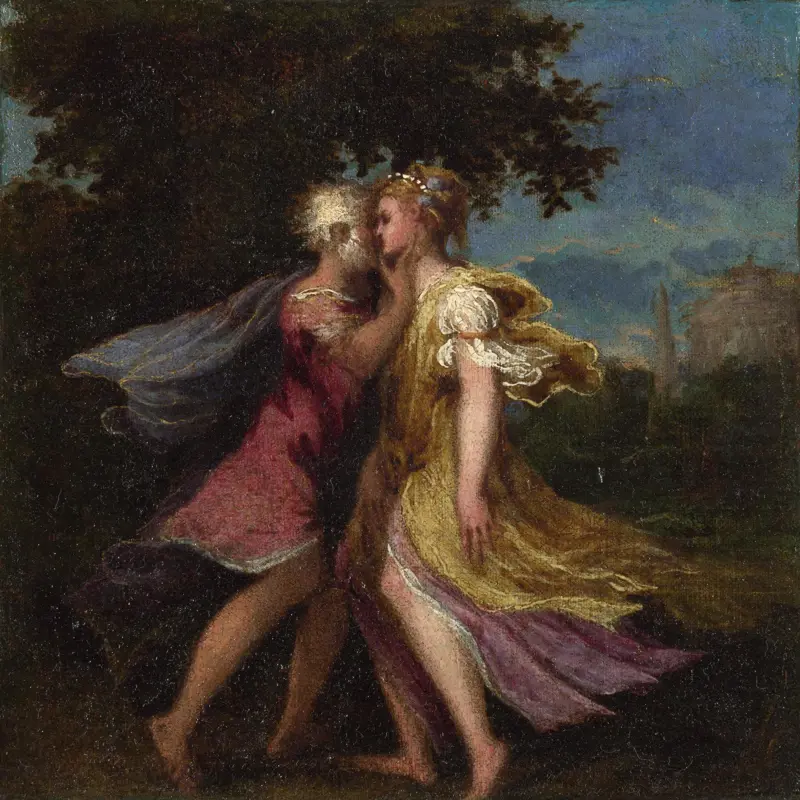Andrea Schiavone, 'Arcas Hunting', about 1550
About the work
Overview
This is one of three mythological scenes to decorate a cassone, or chest, illustrating the story of Callisto as told in Ovid’s Metamorphoses. Jupiter seducing Callisto, also in the National Gallery, decorated the other end.
Arcas, son of Jupiter and Callisto, draws back his bow. A bear emerges from the woody undergrowth on the left. The green of the foliage surrounding the bear has darkened over time to brown, making it difficult to see. Gold leaf glimmers through the sunlit trees and a breeze sweeps back Arcas’s hair, which, like his bow, arrow and quiver, has been highlighted with gold. The delicate beauty of this scene belies the tragic events about to unfold.
The front of the cassone showed Callisto’s fellow nymphs revealing her pregnancy by Jupiter to the goddess Diana (Musée Picardie, Amiens). Furious, Diana turned Callisto into a bear. Here, Arcas goes out hunting and, not realising that the bear is his mother, he shoots her dead.
Key facts
Details
- Full title
- Arcas Hunting
- Artist
- Andrea Schiavone
- Artist dates
- Active about 1530; died 1564
- Part of the series
- Two Mythological Scenes
- Date made
- About 1550
- Medium and support
- Oil on canvas
- Dimensions
- 18.8 × 18.4 cm
- Acquisition credit
- Bought, 1860
- Inventory number
- NG1883
- Location
- Not on display
- Collection
- Main Collection
- Frame
- 20th-century Replica Frame
Provenance
Additional information
Text extracted from the ‘Provenance’ section of the catalogue entry in Nicholas Penny, ‘National Gallery Catalogues: The Sixteenth Century Italian Paintings’, vol. 2, ‘Venice 1540–1600’, London 2008; for further information, see the full catalogue entry.
Exhibition history
-
2009Titian, Tintoretto, Veronese: Rivals in Renaissance VeniceMusée du Louvre17 September 2009 - 4 January 2010
-
2015Splendors of the Renaissance in Venice: Andrea Schiavone among Parmigianino, Tintoretto and TitianMuseo Correr28 November 2015 - 10 April 2016
Bibliography
-
1776G.A. Selva and P. Edwards, Catalogo dei quadri, dei disegni e dei libri che trattano dell'arte del disegno della galleria del fu Sig. Conte Algarotti in Venezia, Venice 1776
-
1782G.A. Selva and P. Edwards, Catalogue des tableaux, des desseins et des livres qui traitent de l'art du dessein, de la galerie du feu Comte. Algarotti à Venise, Venice 1782
-
1826Description des objets d'arts qui composent le cabinet de feu M. le baron V. Denon, Paris 1826
-
1826M. Masson St. Maurice, Description des objets d'arts qui composent le cabinet de feu M. le Baron V. Denon, …: Tableaux, dessins et miniatures. 1826 May 1-19, Paris 1826
-
1927E.K. Waterhouse, 'Letters: Three Pictures at Trafalgar Square', The Burlington Magazine, L/291, 1927
-
1959Gould, Cecil, National Gallery Catalogues: The Sixteenth Century Venetian School, London 1959
-
1959C. Gould, The Sixteenth Century Italian Schools, London 1959
-
1975C. Gould, Delaroche and Gautier: Gautier's Views on the 'Execution of Lady Jane Grey' and on other Compositions by Delaroche, London 1975
-
1980F.L. Richardson, Andrea Schiavone, Oxford 1980
-
1987Gould, Cecil, National Gallery Catalogues: The Sixteenth Century Italian Schools, London 1987
-
1999P. Rosenberg, Dominique-Vivant Denon: L'oeil de Napoléon (exh. cat. Musée du Louvre, 20 October 1999 - 17 January 2000), Paris 1999
-
2001
C. Baker and T. Henry, The National Gallery: Complete Illustrated Catalogue, London 2001
-
2004P. Humfrey, The Age of Titian: Venetian Renaissance Art from Scottish Collections (exh. cat. National Gallery of Scotland, 5 August - 5 December 2004), Edinburgh 2004
-
2005P.D. Massar, 'A Woodcut by Antonio Belemo', Print Quarterly, XXII/4, 2005, pp. 434-7
-
2008Penny, Nicholas, National Gallery Catalogues: The Sixteenth Century Italian Paintings, 2, Venice, 1540-1600, London 2008
Frame
Made in England in 1997, this frame is crafted from walnut wood with gilt accents, an effect known as ‘lumeggiato in oro’. It is modelled on an Italian Renaissance moulding. The frame features straight gadroons along the outer reverse moulding and round flutes on the inner hollow. The corners are embellished with acanthus leaves. The flat frieze has a double bead-and-reel motif along the sight edge.
Schiavone’s small painting Arcas Hunting once adorned the end of a wooden cassone, or chest. The new frame was designed to evoke the style of the original sixteenth-century furniture, which was often made from walnut and adorned with golden highlights.
About this record
If you know more about this work or have spotted an error, please contact us. Please note that exhibition histories are listed from 2009 onwards. Bibliographies may not be complete; more comprehensive information is available in the National Gallery Library.
Images
About the series: Two Mythological Scenes

Overview
These are two of three paintings made to decorate the front and sides of a wooden chest, known in Italian as a cassone. They depict the story of the nymph Callisto, as told in Ovid’s Metamorphoses. Such chests were important pieces of furniture used for storing clothes and household linen. A bride would be given one by her parents as a wedding gift and she would take it with her to her marital home.
Jupiter seducing Callisto is the first episode depicted. While Callisto was resting in a leafy glade, Jupiter appeared disguised as Diana, goddess of chastity. He seduced Callisto and made her pregnant. In the long painting for the front of the cassone (Musée de Picardie, Amiens) Callisto’s fellow nymphs reveal her pregnancy to Diana. When Diana discovered that Callisto was pregnant, she turned her into a bear. In the third episode of the story the bear is shot dead by Callisto’s son Arcas, who does not realise that it is his mother.


